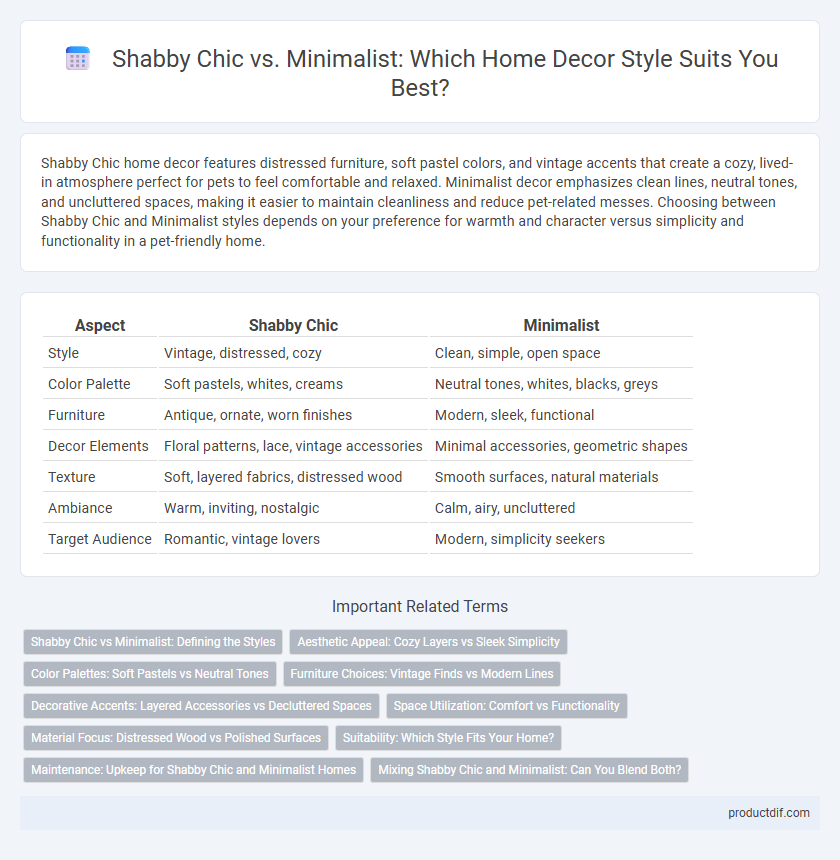Shabby Chic home decor features distressed furniture, soft pastel colors, and vintage accents that create a cozy, lived-in atmosphere perfect for pets to feel comfortable and relaxed. Minimalist decor emphasizes clean lines, neutral tones, and uncluttered spaces, making it easier to maintain cleanliness and reduce pet-related messes. Choosing between Shabby Chic and Minimalist styles depends on your preference for warmth and character versus simplicity and functionality in a pet-friendly home.
Table of Comparison
| Aspect | Shabby Chic | Minimalist |
|---|---|---|
| Style | Vintage, distressed, cozy | Clean, simple, open space |
| Color Palette | Soft pastels, whites, creams | Neutral tones, whites, blacks, greys |
| Furniture | Antique, ornate, worn finishes | Modern, sleek, functional |
| Decor Elements | Floral patterns, lace, vintage accessories | Minimal accessories, geometric shapes |
| Texture | Soft, layered fabrics, distressed wood | Smooth surfaces, natural materials |
| Ambiance | Warm, inviting, nostalgic | Calm, airy, uncluttered |
| Target Audience | Romantic, vintage lovers | Modern, simplicity seekers |
Shabby Chic vs Minimalist: Defining the Styles
Shabby Chic embraces vintage charm with distressed furniture, soft pastel colors, and floral patterns, creating a cozy, nostalgic atmosphere. Minimalist design focuses on simplicity, featuring clean lines, neutral tones, and uncluttered spaces to promote calm and functionality. Both styles prioritize aesthetic appeal but differ fundamentally in texture, color palette, and overall mood.
Aesthetic Appeal: Cozy Layers vs Sleek Simplicity
Shabby Chic aesthetics emphasize cozy layers with distressed furniture, pastel tones, and vintage accessories that create a warm, inviting atmosphere. Minimalist decor features sleek simplicity through clean lines, neutral palettes, and uncluttered spaces, fostering a sense of calm and order. Both styles appeal to different tastes by balancing texture and color to either evoke comfort or maintain modern elegance.
Color Palettes: Soft Pastels vs Neutral Tones
Shabby Chic decor embraces soft pastels like blush pink, mint green, and dusty blue to create a cozy, vintage-inspired atmosphere, while Minimalist design relies on neutral tones such as white, beige, gray, and black to maintain a clean, uncluttered space. Soft pastels in Shabby Chic evoke a sense of warmth and nostalgia, contrasting with the calm and simplicity conveyed by the muted Neutral Tones in Minimalist interiors. Color palettes serve as a key differentiator, shaping the overall mood and style of each decor approach.
Furniture Choices: Vintage Finds vs Modern Lines
Shabby Chic furniture features distressed finishes, ornate details, and vintage finds that create a cozy, nostalgic atmosphere. Minimalist furniture emphasizes sleek, clean lines with functional designs often made from modern materials like metal and glass. Choosing between these styles depends on whether you prefer eclectic charm or streamlined simplicity in your home decor.
Decorative Accents: Layered Accessories vs Decluttered Spaces
Shabby Chic decor emphasizes layered decorative accents such as vintage frames, distressed vases, and floral cushions to create a cozy, nostalgic atmosphere. Minimalist style prioritizes decluttered spaces with a focus on sleek, functional accessories like geometric planters and simple, monochrome art pieces. The contrast lies in Shabby Chic's abundant ornamentation versus Minimalism's restrained, purposeful selection of decor.
Space Utilization: Comfort vs Functionality
Shabby Chic interiors emphasize comfort by incorporating plush, vintage furnishings that create a cozy, inviting atmosphere, often prioritizing aesthetic charm over space efficiency. In contrast, Minimalist design maximizes functionality through clean lines and uncluttered spaces, optimizing room usage with multipurpose furniture and streamlined storage solutions. Both styles balance space utilization differently--Shabby Chic fosters warmth and relaxation, while Minimalist enhances practicality and openness.
Material Focus: Distressed Wood vs Polished Surfaces
Shabby Chic style emphasizes distressed wood, showcasing weathered textures and vintage finishes that evoke a cozy, nostalgic atmosphere. Minimalist decor prioritizes polished surfaces like glass, metal, and sleek laminates, creating clean lines and a streamlined, modern look. The choice between distressed wood and polished materials defines the tactile and visual contrast central to these home decor styles.
Suitability: Which Style Fits Your Home?
Shabby Chic design suits homes with cozy, vintage elements and a preference for soft, distressed furniture and floral patterns, creating a warm, inviting atmosphere. Minimalist style fits modern spaces emphasizing clean lines, neutral colors, and clutter-free environments, ideal for those seeking simplicity and functionality. Choosing between Shabby Chic and Minimalist depends on your home's architectural features and your preference for either decorative charm or streamlined elegance.
Maintenance: Upkeep for Shabby Chic and Minimalist Homes
Shabby Chic decor requires regular upkeep to maintain its distressed finishes and vintage charm, including gentle cleaning and periodic touch-ups to prevent wear from becoming damage. Minimalist homes demand less frequent maintenance due to their simple design and fewer decorative elements, with a focus on keeping surfaces clutter-free and sleek. Both styles benefit from consistent care to preserve their distinct aesthetic qualities and ensure long-term appeal.
Mixing Shabby Chic and Minimalist: Can You Blend Both?
Mixing shabby chic and minimalist styles creates a unique home decor balance by combining vintage charm with clean simplicity. Incorporate distressed furniture and soft pastel colors from shabby chic alongside minimalist sleek lines and neutral tones to achieve harmony. This blend adds warmth and texture while maintaining the uncluttered, airy feel of minimalist design.
Shabby Chic vs Minimalist Infographic

 productdif.com
productdif.com